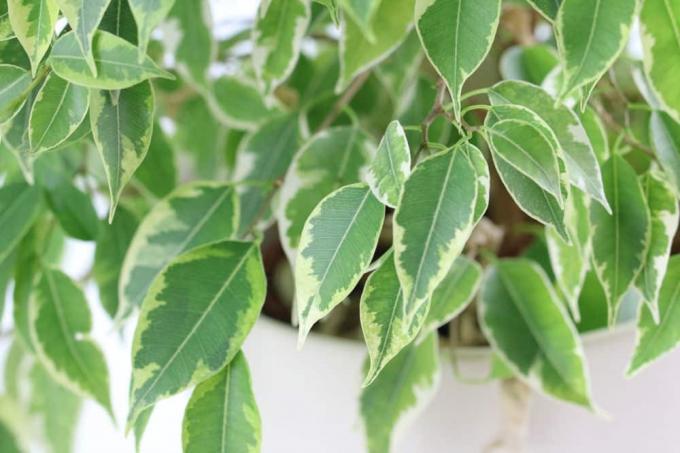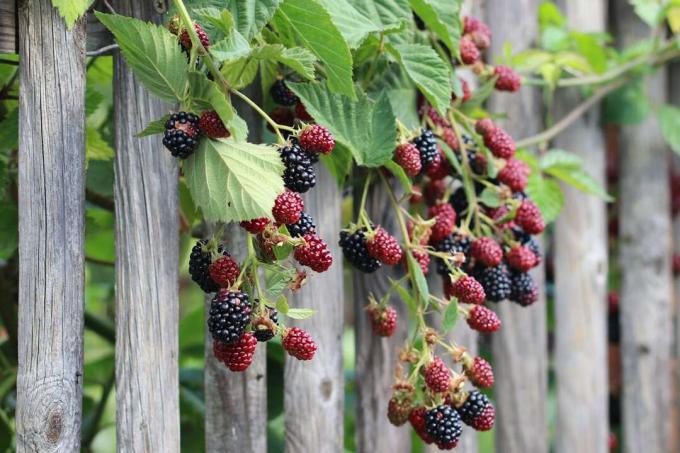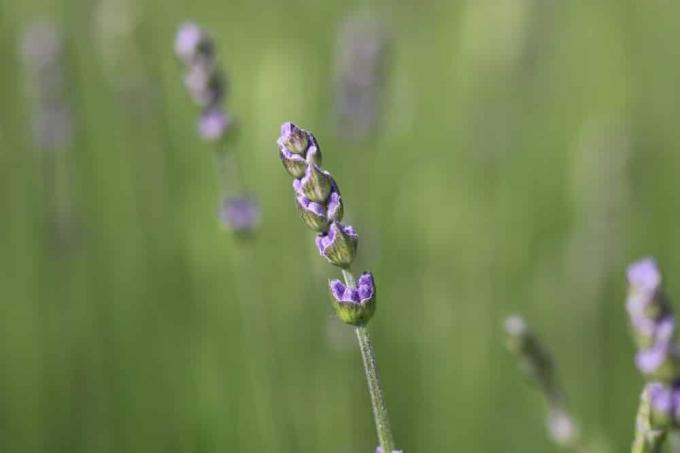

Table of contents
- When is the best time?
- Important preparatory work - be careful with the sap
- Instructions for the shape and maintenance cut
- Cutting back Ficus Benjamini radically – Instructions for the rejuvenation cut
- Raise Ficus Benjamini to a high trunk
- Cut birch figs as bonsai
Strictly speaking, the pronounced cut tolerance of a Ficus Benjamini allows it to be cut back at any time. If individual, disturbing branches catch your eye, you can cut them off immediately.
When is the best time?
On the other hand, if you subject the birch fig to an extensive topiary or want to cut back the ornamental wood completely, this should be done in winter. You will achieve the best success when fresh budding is imminent in the transition from late winter to spring. Of course, an annual pruning is not a must for your birch fig. In contrast to other shrubs and trees, the scissors on the Ficus Benjamini are used when needed and not at fixed time intervals.
Important preparatory work - be careful with the sap
Weeping figs are permeated with a poisonous milky sap. If it comes into contact with the skin, the sticky secretion can cause a rash, eczema and other allergic reactions, including anaphylactic shock. If the plant sap drips onto your valuable parquet, laminate or carpet, the stains are very difficult to remove. The bigger the cuts, the more toxic sap leaks out. Therefore, please pay particular attention to the following preparatory work:
- When cutting in winter, cover the ground with tarps, old newspapers or old curtains
- When pruning in spring or summer, cut the birch fig outside on soil or grass
- Sharpen the blades of the scissors and disinfect with alcohol
- Put on gloves and long-sleeved clothing
To quickly stop the flow of juice, have small pieces of absorbent pads or torn Tempo handkerchiefs ready. If you press a piece of fleece on the wound after each cut, the milky juice cannot drip onto the leaves or the ground.
A notice:
Did you know that sticky leaves on a birch fig are not necessarily due to the poisonous plant sap. If the damage occurs days or even weeks after the last cut, it may be an aphid infestation. The sucking pests excrete sticky honeydew as a waste product, which sticks together the pretty leaves.
Instructions for the shape and maintenance cut

If you have ordered your Ficus Benjamini to be pruned, the preparations recommended here are first on the agenda. The actual cut does not involve any gardening stumbling blocks, as you can cut back into the old wood yourself and still drive out the plants cheerfully. In order for the birch fig to then sprout nice and bushy and compact, the following cut is advisable:
- Cut off all dead shoots at the beginning
- Remove branches that grow transversely and are directed inwards from the bush or crown
- Remove the older or weaker branches from branches that are too close together
- Shorten any branches sticking out of the mould
- Immediately cover each cut with a piece of fleece
Position the scissors so that 3 to 5 mm is below one of the alternate leaves or a node. The shorter the distance between the interface and the leaf or node, the more vital the fresh shoots are. If there is any doubt as to whether a shoot has died or not, carry out a vitality test. Scrape off a little bark from the branch. If you see brownish-dry tissue underneath, cut off the shoot completely. A fresh green color, on the other hand, indicates that you can hope for another leaf to sprout on this branch.
Tip:
Your Ficus Benjamini wears its most beautiful foliage when it is allowed to stay on the balcony from June to September. As long as the night-time temperatures do not fall below 16 degrees Celsius, the tropical ornamental tree feels at home in a partially shaded location.
Cutting back Ficus Benjamini radically – Instructions for the rejuvenation cut
Various causes can make it necessary to radically cut back a Ficus Benjamini. In the majority of cases, the tropical shrubs go beyond the spatial dimensions or are bare and senile as a result of neglected care. Now you benefit from the good-natured cut compatibility. The best time for the rejuvenation pruning is in winter, because the stress load is lowest when the sap is dormant. This is how the rejuvenation cut succeeds:
- Cut off dead shoots completely and without stubs
- Cut away all dry, too narrow and cross-growing branches
- Shorten remaining branches by half to two-thirds
Then repot your Ficus Benjamini in fresh substrate to mobilize its floral powers. This opportunity gives you a clear view of the roots when the plant is potted. Remove the old substrate and carefully inspect the bale. Cut off any stunted, rotten-brown, or dried-up roots.
Raise Ficus Benjamini to a high trunk

With a bushy, round crown on a slender trunk, a Ficus Benjamini spreads a pleasant ambience in living and working spaces. Since raising the evergreen tropical beauty is time-consuming, the purchase costs a lot. Leisure gardeners leave their wallets stuck and raise a young birch fig to a standard on their own. Follow these steps:
start phase
- Select the best central shoot on a healthy, strong young plant
- Place a wooden stick in the ground next to the central shoot
- Connect rod and drive with hose clamps or rings
- Alternatively, tie several ground shoots together to form a trunk
construction phase
- Cut off all competing shoots of the main shoot at the base
- Cut or tear off side branches on the future trunk
- Guide the central drive successively upwards on the support rod
crown education
- Only cut off the shoot tip when the desired trunk height has been reached
- Start the cut 3 to 4 leaves above the desired crown height
- Shorten side branches of the crown by a third to encourage branching
- Cut side branches radically below the crown up to the trunk without a stub
To develop a shapely crown over time, regularly remove any stunted branches that are growing in the wrong direction. Please make sure to remove deadwood regularly so that the crown is always flooded with light. Ideally, the branches are arranged like a perfectly tied bouquet.
In the further course of the crown training leads to a shape and maintenance cut according to these instructions. Thin out deadwood every late winter. To what extent individual or all branches are to be cut back, you decide individually after a thinning cut. Step back a few steps and examine the shape of the crown.
Tip:
If a birch fig sheds its beautiful leaves, this is no reason for a pruning. The exotic green plant reacts to unsuitable conditions with leaf fall.
The most common causes are abrupt change of location, draft and cold roots. Once the problems have been resolved, fresh green will soon sprout on the bare branches.
Cut birch figs as bonsai

In the professional pruning of Ficus Benjamini as bonsai, other standards apply in terms of frequency and pruning. In order to wrest the characteristic mini format from the strong-growing tropical tree, cutting back once a year is not enough. The following brief instructions summarize the correct procedure:
- Prune at 6 week intervals from April to September
- Cut new branches with 5 to 7 leaves back to 2 to 3 leaves
- Cut off individual shoots protruding from the crown mould
- Thin out dead wood in spring and again in autumn
- In connection with each repotting, shorten the roots by a third
- Dab bleeding cuts with kitchen towels or dust with charcoal ash
An authentic design pursues the goal that in the end there is no thick twig over a thin twig. Give your bonsai enough time between pruning appointments for regeneration and further growth. The masters of Asian bonsai art do not constantly abuse the green works of art with scissors, but leave the mini ficus undisturbed for a long time and enjoy the charismatic appearance.
 Home editorial office
Home editorial office
Learn more about pruning

Eucalyptus dried up: cut back now?
When a eucalyptus dries up, some owners immediately think of cutting it back. Because they want to see fresh green bud quickly. The chances of that happening may be good. But one thing must not be left out: research into the causes! Otherwise a new cycle of drying up and cutting begins.

Cut blackberries: Instructions for the right cut
Bramble branches only bear fruit for one summer, after which they are used up and die off in winter. It's a good thing that new canes grow back in time for the following year. Cutting care means: What no longer supports should be removed, young rods must be optimally trained.

cutting snowball | 13 tips for pruning
When it comes to snowballs (Viburnum), the opinions of numerous hobby gardeners differ when it comes to cutting. Main reason against pruning: Destruction of the natural appearance by pruning. Find out now when it is unavoidable and which tips should be heeded.

Cutting sage: 6 tips for cutting back
Cutting measures and their ideal time depend on the species of sage plants, because they have differentiated ways of life. There are woody and herbaceous representatives that require different attention. In order to carry out the measures, a basic set of tools is helpful.

Pruning hydrangeas: when is the right time?
Hydrangeas are a real beauty because of their flowers. In the long term, however, the flowering power is only maintained if regular pruning takes place. Because cutting off withered or dried plant parts offers protection. The following guide shows when this measure should be taken.

Cutting Lavender | When is the best time?
Lavender is a popular perennial, but difficult to cut. Without regular pruning, the shrub becomes lignified and less robust. Choosing the right time is important for pruning. When to cut depends on the use of the perennials.



